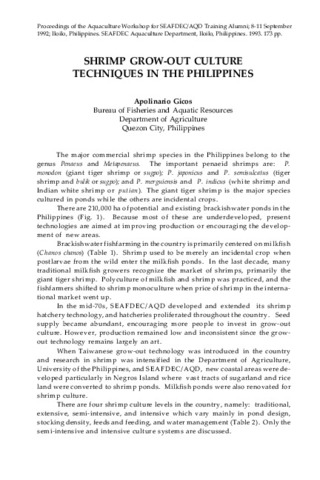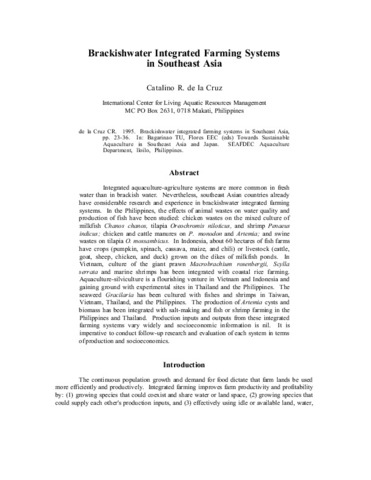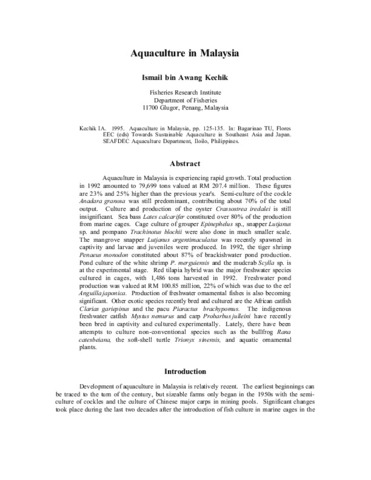Shrimp grow-out culture techniques in the Philippines
- Global styles
- MLA
- Vancouver
- Elsevier - Harvard
- APA
- Help
Share
Abstract
The major commercial shrimp species in the Philippines belong to the genus Penaeus and Metapenaeus. The important penaeid shrimps are: P. monodon (giant tiger shrimp or sugpo); P. japonicus and P. semisulcatus (tiger shrimp and bulik or sugpo); and P. merguiensis and P. indicus (white shrimp and Indian white shrimp or putian). The giant tiger shrimp is the major species cultured in ponds while the others are incidental crops.
There are 210,000 ha of potential and existing brackishwater ponds in the Philippines (Fig. 1). Because most of these are underdeveloped, present technologies are aimed at improving production or encouraging the development of new areas.
Brackishwater fishfarming in the country is primarily centered on milkfish (Chanos chanos) (Table 1). Shrimp used to be merely an incidental crop when postlarvae from the wild enter the milkfish ponds. In the last decade, many traditional milkfish growers recognize the market of shrimps, primarily the giant tiger shrimp. Polyculture of milkfish and shrimp was practiced, and the fishfarmers shifted to shrimp monoculture when price of shrimp in the international market went up.
In the mid-70s, SEAFDEC/AQD developed and extended its shrimp hatchery technology, and hatcheries proliferated throughout the country. Seed supply became abundant, encouraging more people to invest in grow-out culture. However, production remained low and inconsistent since the growout technology remains largely an art.
When Taiwanese grow-out technology was introduced in the country and research in shrimp was intensified in the Department of Agriculture, University of the Philippines, and SEAFDEC/AQD, new coastal areas were developed particularly in Negros Island where vast tracts of sugarland and rice land were converted to shrimp ponds. Milkfish ponds were also renovated for shrimp culture.
There are four shrimp culture levels in the country, namely: traditional, extensive, semi-intensive, and intensive which vary mainly in pond design, stocking density, feeds and feeding, and water management (Table 2). Only the semi-intensive and intensive culture systems are discussed.
Suggested Citation
Gicos, A. (1993). Shrimp grow-out culture techniques in the Philippines. In C. T. Villegas, M. T. Castaños, & R. B. Lacierda (Eds.), Proceedings of the Aquaculture Workshop for SEAFDEC/AQD Training Alumni, 8-11 September 1992, Iloilo, Philippines (pp. 35-45). Tigbauan, Iloilo, Philippines: Aquaculture Department, Southeast Asian Fisheries Development Center.
Type
Conference paperISBN
9718511253
Related items
Showing items related by title, author, creator and subject.
-
Brackishwater integrated farming systems in Southeast Asia
De la Cruz, Catalino R. (Aquaculture Department, Southeast Asian Fisheries Development Center, 1995)Integrated aquaculture-agriculture systems are more common in fresh water than in brackish water. Nevertheless, southeast Asian countries already have considerable research and experience in brackishwater integrated farming ... -
Aquaculture in Malaysia
Kechik, Ismail bin Awang. (Aquaculture Department, Southeast Asian Fisheries Development Center, 1995)Aquaculture in Malaysia is experiencing rapid growth. Total production in 1992 amounted to 79,699 tons valued at RM 207.4 million. These figures are 23% and 25% higher than the previous year's. Semi-culture of the cockle ... -
Coastal aquaculture in Thailand
Sahavacharin, Songchai (Aquaculture Department, Southeast Asian Fisheries Development Center, 1995)Coastal aquaculture in Thailand has expanded rapidly in both area and production in the last decade. The important cultured species are the shrimps (Penaeus monodon and P. merguiensis), sea bass Lates calcarifer, groupers ...







